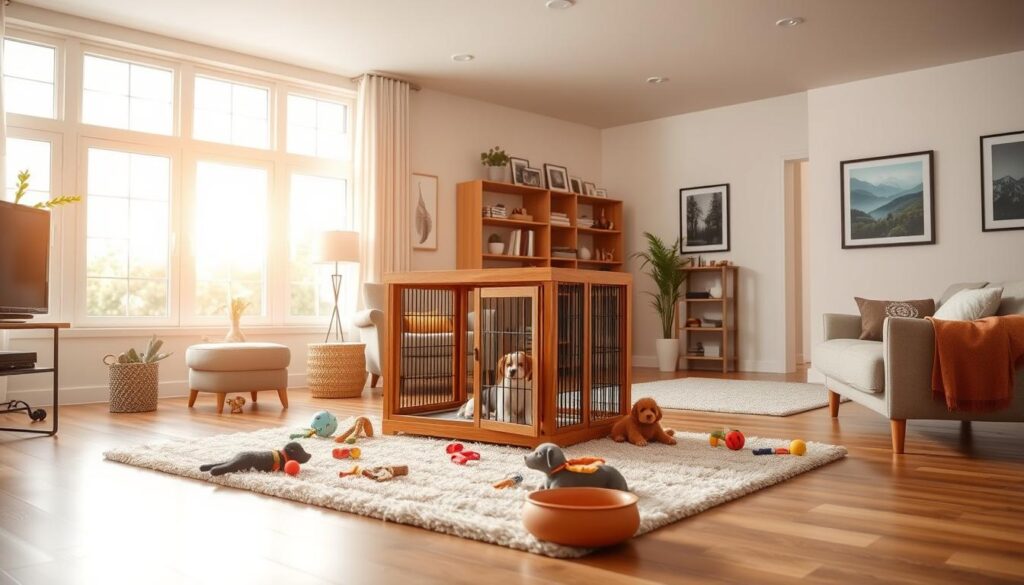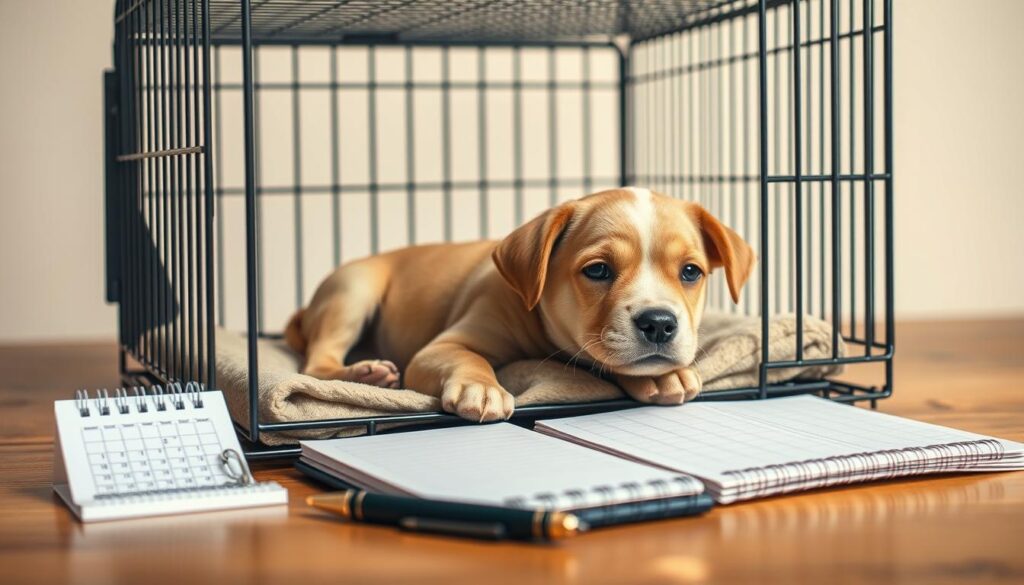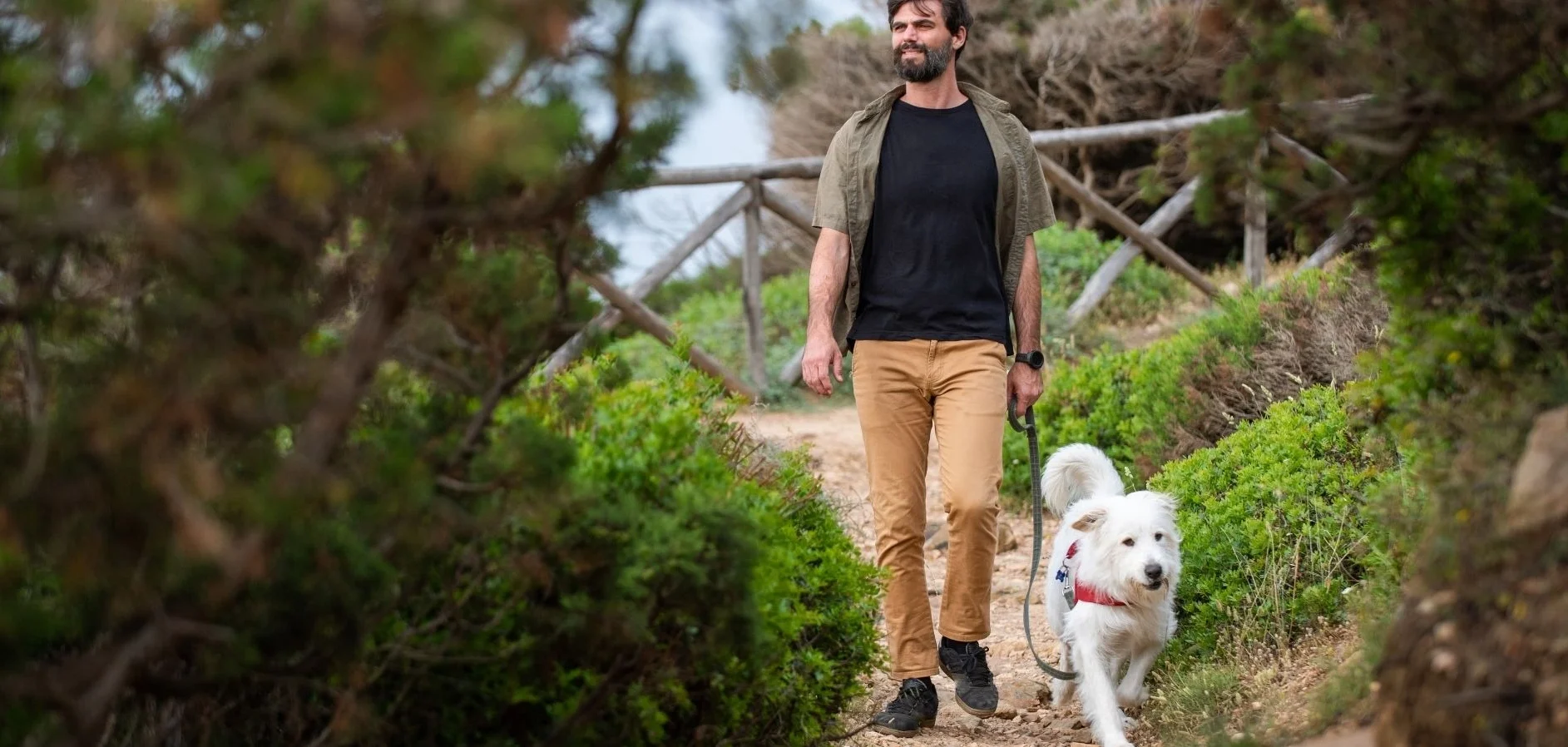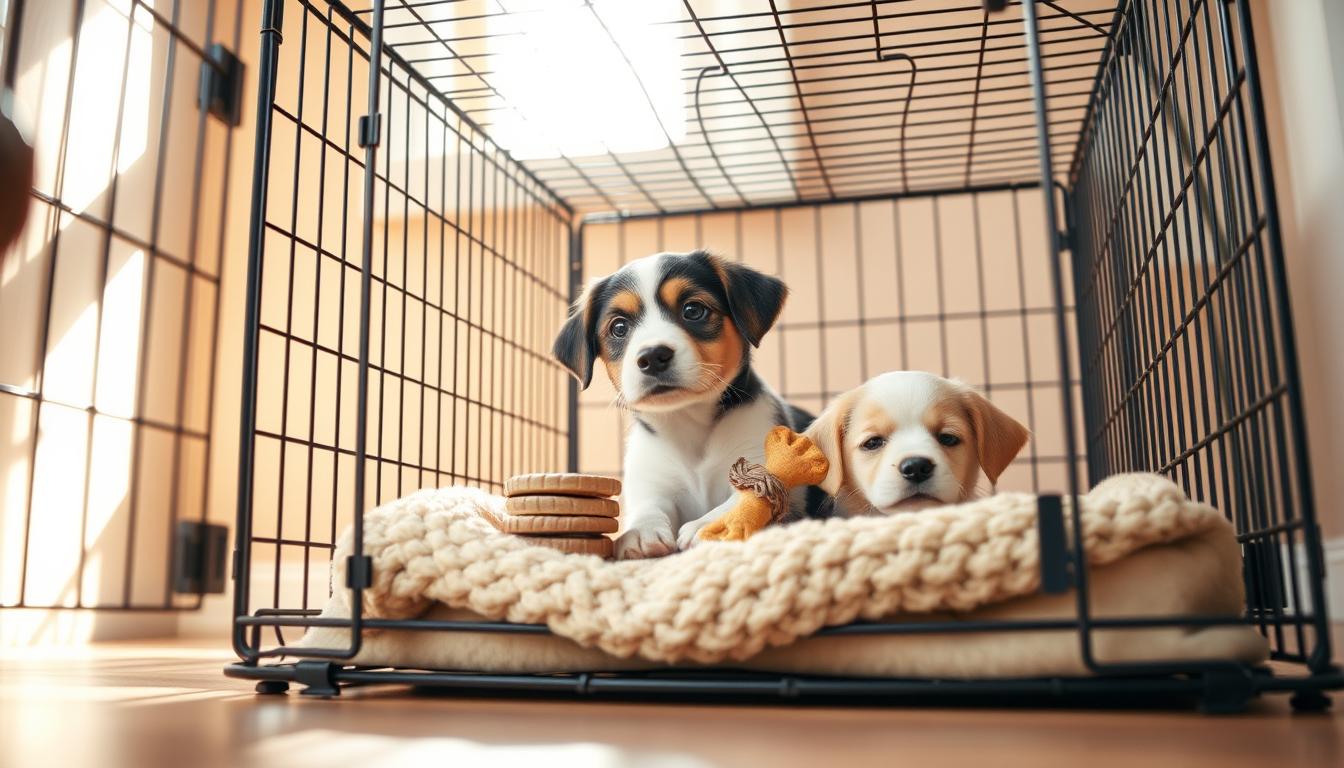Using a Crate to House Train a Puppy: Smart and Safe Approach
Table of Contents
When I brought my first puppy home, sleepless nights and endless accidents seemed inevitable. That was before I discovered the magic of using a crate to house train a puppy. Like many new pet owners, I was skeptical about crate training at first. But it quickly became our secret weapon for creating a harmonious home.
Puppy crate training tips aren’t just about containment. They’re about creating a safe, secure space that speaks to your furry friend’s natural instincts. Dogs are den animals, and a crate can become their personal sanctuary. It’s a place of comfort and security that helps them learn crucial house training skills.
Crate training isn’t about punishment. It’s a gentle, effective method that helps your puppy understand boundaries while providing them with a sense of safety. By understanding how to use a crate to house train a puppy, you’ll create a positive training environment. This sets both you and your new companion up for success.
Key Takeaways
- Crate training taps into your puppy’s natural den instincts
- Creates a safe, personal space for your young dog
- Helps establish effective house training routines
- Reduces potential anxiety and destructive behaviors
- Provides a consistent training method for puppies
Understanding the Importance of Crate Training for Puppies
Crate training is a great way to raise a well-adjusted puppy. It offers many benefits for both you and your puppy. It uses your puppy’s natural instincts to create a safe space for them to grow.
Dogs are naturally drawn to cozy, protected spaces. Crate training taps into this instinct. It makes training easier and more effective for new puppies.
Natural Den Instincts in Dogs
Wild canines look for small, enclosed spaces for safety and comfort. Your puppy has these instincts too. A crate provides a sense of security, reducing anxiety and stress.
- Provides a safe personal space
- Satisfies natural den-dwelling instincts
- Creates a sense of security
Safety and Security Benefits
Crate training offers more than just a place to stay. It provides important safety benefits for your puppy and your home.
| Safety Benefit | Explanation |
|---|---|
| Prevents Destructive Behavior | Keeps puppy safe when unsupervised |
| Reduces Accident Risks | Limits access to dangerous household items |
| Supports House Training | Helps develop bladder and bowel control |
Creating a Positive Training Environment
Your approach to crate training is crucial. Patience and positive reinforcement are essential. They help your puppy see the crate as a safe, welcoming space, not a punishment.
By following these principles, you’ll create a supportive environment. Your puppy will feel secure, learn quickly, and develop good habits for life.
Selecting the Right Crate for Your Puppy
Choosing the right crate is key for house training success. The best crate for your puppy depends on several important factors. These factors support your training and keep your puppy comfy.
Size is the most important thing when picking a crate. Your puppy’s crate should let them stand, turn, and lie down easily. But it shouldn’t be so big that they use it as a bathroom.
- Wire Crates: Offer excellent ventilation and adjustability
- Plastic Crates: Provide more den-like security for puppies
- Fabric Crates: Great for travel but less durable for training
Look for these essential features in a crate:
- Adjustable divider panel
- Removable plastic tray for easy cleaning
- Sturdy construction
- Proper ventilation
Measuring your puppy correctly is crucial. A pro tip is to pick a crate for your dog’s adult size. Use a divider to make it the right size for training. This helps prevent accidents and aids in house training.
Remember, the right crate is an investment in your puppy’s training and comfort!
Essential Supplies for Successful Crate Training
Getting the right supplies is key for crate training puppies. The crate should be comfy, fun, and help your puppy learn. The right stuff can make crate training a breeze for you and your puppy.
Bedding and Comfort Items
Choosing the right bedding is important for crate training. Look for:
- Washable and easy to clean
- Chew-resistant
- Comfortable and soft
- Right size for your puppy’s crate
Pro tip: Use a waterproof bed liner for house training to avoid messes.
Training Treats and Rewards
Treats are crucial for crate training. Pick small, tasty rewards that excite your puppy and make crate time good.
- Choose soft, bite-sized treats
- Go for healthy, low-calorie options
- Change up treat types to keep things interesting
Recommended Toys for Crate Time
Fun toys make crate time fun and prevent boredom. Choose safe, interactive toys:
- Puzzle toys with treat compartments
- Chew-safe rubber toys
- Soft plush toys without small parts
- Change toys often to keep things fresh
Always watch your puppy with new toys and replace them if they get old or damaged.
Using a Crate to House Train a Puppy
Using a crate to house train a puppy is a smart move. It taps into your pup’s natural instinct to keep their sleeping area clean. This instinct makes crate training a great way to teach good bathroom habits.
To start crate training, make the crate a positive place. Make it comfy and welcoming. Your puppy should view it as a cozy spot, not a punishment area.
- Choose a crate that allows your puppy to stand, turn around, and lie down comfortably
- Introduce the crate gradually with treats and soft bedding
- Keep crate time short initially, gradually increasing duration
- Use consistent potty break schedules
Creating a routine is key to house training. Puppies need to go outside:
- Immediately after waking up
- After eating or drinking
- After playtime
- Before bedtime
Remember, patience and positive reinforcement are crucial when using a crate to house train a puppy. Never use the crate as punishment. Always make it a rewarding experience for your furry friend.
Consistency is the secret weapon in successful puppy crate training.
Creating an Effective Crate Training Schedule
Creating a consistent crate training schedule is key for successful puppy house training. Your puppy’s learning depends on a routine that meets their needs. A good crate training schedule helps your puppy understand what’s expected and builds their confidence.
Puppies can’t control their bladders well and need to go out often. Your crate training schedule should match your puppy’s age and growth. The goal is to create a routine that helps them learn and avoids accidents.
Daytime Schedule Guidelines
For effective crate training during the day, follow these essential guidelines:
- Puppies under 3 months: Potty breaks every 1-2 hours
- Puppies 3-6 months: Potty breaks every 2-3 hours
- Limit crate time to 3-4 hours maximum during daytime
- Provide short play and exercise sessions between crate times
Nighttime Routine Tips
Nighttime crate training needs patience and consistency. Young puppies can’t hold their bladder for long. Here are some tips:
- Place crate near your bedroom for monitoring
- Take puppy out immediately before bedtime
- Set an alarm for middle-of-the-night potty breaks
- Gradually increase sleep duration as puppy grows
Feeding and Potty Break Timing
Match your puppy’s feeding schedule with crate and potty breaks. Puppies usually need a potty break 15-30 minutes after eating. Keep a consistent feeding routine to better predict when they’ll need to go.
“Consistency is the secret to successful crate training” – Professional Dog Trainers
Proper Crate Placement in Your Home

Choosing the right spot for your puppy’s crate is key for their training and comfort. Where you place the crate can greatly affect their learning and happiness.
When picking a spot for crate training, keep these points in mind:
- Choose a location with moderate family activity
- Ensure the area is free from excessive noise and drafts
- Select a space with consistent temperature
- Avoid isolated areas like basements or garages
Good places for your puppy’s crate include:
- Living room corner
- Dining area near family gathering spaces
- Bedroom during nighttime
- Home office with moderate foot traffic
| Location Type | Pros | Cons |
|---|---|---|
| Living Room | Close to family, social interaction | Potential distractions |
| Bedroom | Quiet, secure for nighttime | Limited daytime interaction |
| Home Office | Controlled environment | Potential work interruptions |
Pro tip: Use a crate cover to make your puppy feel safe and secure during crate training.
Remember, being flexible is important. You might need to try different spots to find the best one for your puppy’s comfort and family integration during crate training.
Positive Reinforcement Techniques for Crate Training
Crate training for puppies is all about making them feel safe and happy. It’s about building trust and excitement around the crate. This makes crate training successful.
Training puppies to use crates needs patience and encouragement. You want to make the crate a comfortable, welcoming place. This turns the crate from a source of anxiety to a cozy spot.
Reward-Based Training Methods
- Use high-value treats specific to puppy training
- Offer immediate praise when puppy enters crate voluntarily
- Create short, positive crate experiences
- Gradually increase crate time with consistent rewards
Choosing the right rewards is key in crate training puppies. Small, soft treats are best for quick training sessions.
Building Positive Associations
| Technique | Purpose | Frequency |
|---|---|---|
| Feeding near crate | Create positive connection | Daily |
| Treat placement inside crate | Encourage voluntary entry | Multiple times daily |
| Calm praise | Reinforce good behavior | Every interaction |
“Patience and consistency are the foundations of successful puppy crate training.” – Professional Dog Trainer
Remember, every puppy is different. Crate training should fit your dog’s personality and comfort level.
Common Crate Training Challenges and Solutions
Puppy crate training tips can help you tackle common pet owner challenges. Knowing these issues makes training easier and more effective.
Dogs face various problems during crate training. Some might whine, bark, or not want to go into their crate. Others might have accidents inside, which can upset owners.
- Whining and barking are typical initial responses
- Reluctance to enter the crate can indicate anxiety
- Accidents inside the crate require careful management
Professional dog trainers suggest patience and consistent training tips. Dr. Karen Burch, a veterinary behaviorist, says dogs from small spaces might find crate training harder.
| Challenge | Solution |
|---|---|
| Excessive Whining | Ignore noise, reward quiet behavior |
| Crate Avoidance | Use treats, make crate comfortable |
| Accidents | Increase potty breaks, clean thoroughly |
If your puppy still has trouble with crate training, get professional help. A certified dog trainer can offer strategies that fit your puppy’s needs.
“Consistency and positive reinforcement are key to successful crate training” – Professional Dog Trainers Association
Remember, every puppy is unique. What works for one might not work for another, so be patient and adaptable in your approach.
Monitoring Your Puppy’s Progress
Using a crate to house train a puppy needs patience and watching closely. It helps you see how they’re learning and adjust your training if needed.

Good crate training means knowing when your puppy is getting it. Look for these signs:
- Willingly entering the crate without resistance
- Remaining calm and relaxed inside the crate
- No signs of anxiety or distress during crate time
- Consistent potty training success
Evaluating Training Progress
Keeping a training log is key when crate training a puppy. It shows how they’re improving and what needs work.
| Progress Indicator | Positive Signs | Areas for Improvement |
|---|---|---|
| Crate Comfort | Relaxed posture | Excessive whining |
| Potty Training | Fewer accidents | Irregular bathroom breaks |
| Crate Acceptance | Voluntary entry | Resistance to crate |
When to Adjust Your Approach
If you face ongoing challenges, try these changes:
- Gradually increase crate time
- Modify reward techniques
- Reassess crate placement
- Consult a professional trainer if needed
Remember, every puppy learns differently. Celebrate small victories and remain consistent in your training efforts.
Transitioning from Crate Training to House Freedom
Crate training a new puppy is a key step towards independence. As your puppy grows and shows good behavior, it’s time to give them more freedom at home.
Knowing when your puppy is ready for more space is important. Look for these signs:
- Consistently follows house training rules
- Shows calm behavior in the crate
- No longer displays destructive chewing habits
- Responds well to basic commands
Begin the transition slowly. Start with short, supervised times outside the crate. Puppy-proof your living spaces to avoid accidents or damage.
Here’s a structured way to expand your puppy’s freedom:
- Start with 10-15 minute supervised periods
- Gradually increase freedom time
- Continue using the crate when unsupervised
- Maintain consistent training routines
Remember, crate training builds trust and positive habits. Even with more freedom, keep up the good training. The crate is still a safe and useful tool for your puppy’s growth.
Maintaining Good Crate Habits Long-Term
As your puppy grows up, keeping good crate habits is key. Crate training benefits your dog long after they learn it. It gives them a safe, cozy spot for life.
Consistent crate training brings many long-term benefits:
- Creates a secure personal space for your dog
- Helps manage stress during medical procedures
- Facilitates easier travel and transportation
- Provides a reliable retreat during household disruptions
Continuing to use the crate positively is key to long-term success. Make sure to include short crate sessions every day. Use it for meals, quiet time, or when you need your dog to stay calm.
“A well-maintained crate is more than a training tool – it’s a lifelong companion for your dog.”
Keep an eye out for any signs of anxiety or resistance from your dog. If you see these signs, go back to positive reinforcement. Slowly cut back on crate time as your dog gets older. But always have it ready as a safe spot.
The aim of crate training is to make a positive, comfy space for your dog. It should be their personal sanctuary for life.
Conclusion
Using a crate to house train a puppy needs dedication and understanding. By following the strategies in this guide, you can make crate training a positive experience. It’s all about being consistent, patient, and supportive.
Remember, crate training does more than just teach house training. It builds trust and communication between you and your puppy. Every step you take helps your puppy grow and feel safe.
Training might have tough moments, but keep going. Most puppies learn fast with gentle guidance and positive rewards. Soon, you’ll have a routine that helps your puppy become well-adjusted and house-trained.
Begin your crate training journey with confidence. With the right knowledge and techniques, you can help your puppy become a well-behaved family member. They’ll understand boundaries and feel safe in their space.
FAQ
How long does it take to crate train a puppy?
Crate training usually takes 4-6 weeks. It depends on your puppy’s age, how they act, and how often you train them. Young puppies might learn faster, but being patient and using positive methods is key.
What size crate should I get for my puppy?
Pick a crate where your puppy can stand, turn, and lie down easily. Many crates have divider panels. These can be adjusted as your puppy grows, helping with house training.
How long can a puppy stay in a crate during the day?
Puppies can hold their bladder for about an hour for each month of age. So, an 8-week-old puppy can stay in a crate for 2 hours a day. Make sure to give them breaks and exercise.
Is crate training cruel?
No, crate training is not cruel if done right. It uses a dog’s natural instinct to find a safe space. When introduced positively, the crate becomes a cozy spot, not a punishment.
How do I stop my puppy from crying in the crate?
Make the crate a nice place with treats and comfy bedding. Ignore the whining. Increase crate time slowly and give lots of exercise and potty breaks before.
Where should I place the puppy’s crate?
Put the crate in a quiet spot but not alone during the day. At night, many suggest it in your bedroom. This makes your puppy feel safe and makes potty breaks easier.
Can I use the crate for punishment?
No, you should never use the crate as punishment. It should always be a positive space. Punishment will make training harder and create negative feelings.
How often should I take my puppy out when crate training?
Puppies need potty breaks every 1-2 hours during the day. Take them out after waking, meals, playtime, and before the crate. A consistent routine helps with house training.
What if my puppy has an accident in the crate?
Clean the crate well with an enzymatic cleaner to remove smells. Don’t scold your puppy. It can make them anxious. Make sure the crate is the right size and adjust potty breaks as needed.
When can I start leaving my puppy out of the crate?
Puppies can have more freedom around 6-8 months old. It depends on their growth and training. Start with short, supervised times and increase it as they show reliable behavior.
There are no reviews yet. Be the first one to write one.


